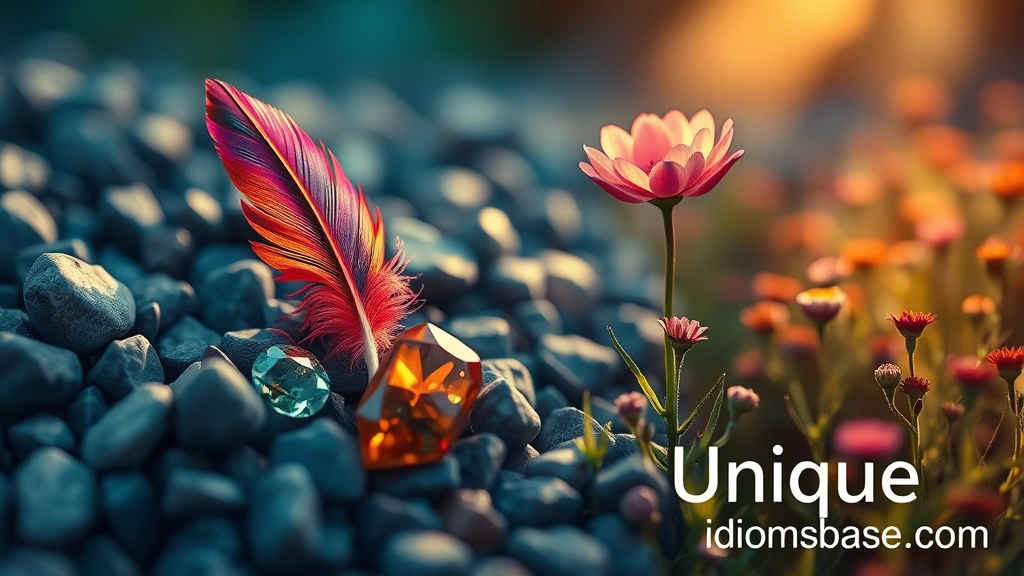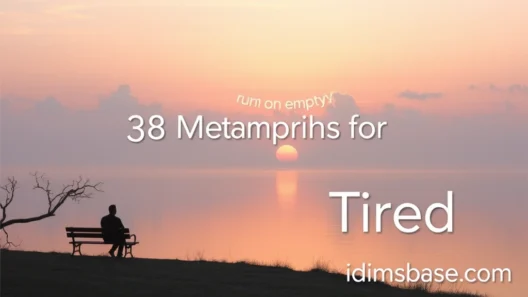Have you ever tried to describe something truly one-of-a-kind, something that defies easy categorization? It's a delightful challenge, isn't it? When "unique" just doesn't quite capture the magic, that's when metaphors swoop in like superheroes of language! They transform the ordinary into the extraordinary, painting vivid pictures with words. Get ready to dive into a treasure trove of imaginative ways to express that special, unparalleled quality.
Unpacking the Essence of "Unique"
Before we unleash our metaphorical arsenal, let's take a moment to appreciate what "unique" truly means. It's not just "different," is it? It implies a singular, unmatched quality, a deviation from the norm that makes something stand out in a crowd. Think of it as a fingerprint – no two are exactly alike. It's about individuality, rarity, and an inimitable spirit.
Why Metaphors Matter for Describing Uniqueness
Metaphors are powerful tools because they allow us to understand complex ideas by comparing them to simpler, more familiar ones. When you say something is something else, you're not just making a comparison; you're creating a new reality, a new way of seeing. For uniqueness, this is crucial. It helps us convey the depth and breadth of that special quality in a way that goes beyond mere adjectives.
38 Metaphors for Uniqueness: A Galaxy of One-of-a-Kind Expressions!
Let's embark on a linguistic adventure! Here are 38 dazzling metaphors to help you articulate that truly unique essence.
Category 1: The Artisan's Touch – Crafted for One
These metaphors evoke the idea of something meticulously created, with no duplicates.
- A master key: It opens every lock, a singular solution tailored perfectly.
- A bespoke suit: Tailored precisely for one, fitting like no other.
- A handcrafted jewel: Each facet cut with intention, radiating individual brilliance.
- A custom-built engine: Engineered for specific performance, unmatched in its purpose.
- A sculptor's signature piece: Bearing the artist's unmistakable mark, a singular creation.
Category 2: Nature's Wonders – Born of Distinction
Nature provides countless examples of individuality. These metaphors draw from the organic world.
- A lone star in the night sky: Shining brightly, without a rival in its immediate vicinity.
- A snowflake's intricate pattern: Each one a fleeting, unmatched design.
- A desert bloom: Thriving where others cannot, a rare and beautiful sight.
- A fingerprint: The ultimate symbol of individual identity, impossible to replicate.
- The eye of a storm: A calm, distinct center amidst chaos.
- A rare orchid: Exquisite, delicate, and found in few places.
- A comet's trajectory: Following its own unique path through the cosmos.
- A geode's hidden crystals: Ordinary on the outside, revealing extraordinary beauty within.
Category 3: The World of Arts & Ideas – Inventive & Original
These metaphors highlight creativity, innovation, and breaking new ground.

- A groundbreaking invention: Revolutionizing its field, truly the first of its kind.
- An unwritten chapter: Full of potential, unlike anything that came before.
- A new melody: Never heard, captivating in its fresh arrangement.
- A blank canvas: Waiting for a singular vision to unfold upon it.
- A fresh perspective: Seeing the world in a way no one else has.
- A pioneering spirit: Venturing where no one has gone before.
- A narrative twist: Unexpected, turning the story on its head.
Category 4: Unmatched Qualities – Standing Apart
These metaphors focus on the sheer distinctiveness and unparalleled nature.
- A class of its own: Operating on a level beyond comparison.
- A league apart: Elevated, distinct from the common standard.
- The only one of its kind: A simple, yet powerful statement of singularity.
- A rare bird: Seldom seen, highly valued for its scarcity.
- A white whale: Elusive, legendary, and uniquely challenging to find.
- An anomaly: A deviation from the norm, intriguing in its difference.
- A unicorn: Mythical, magical, and entirely unique.
- An outlier: Existing outside the typical range or pattern.
- A singular voice: Speaking with an unmistakable tone and message.
Category 5: Time & History – Enduring & Unrepeatable
These metaphors draw from the concept of moments and events that cannot be replicated.
- A fleeting moment: Precious because it will never happen again.
- A turning point in history: A singular event that reshapes the future.
- A first impression: Unrepeatable, setting the tone for what follows.
- A once-in-a-lifetime opportunity: A chance that won't come again.
- The dawn of a new era: Marking a distinct beginning, unlike any before.
Category 6: Inner Essence – Distinctive Soul

These metaphors delve into the inherent character or spirit that makes something unique.
- A distinct flavor: Unforgettable, setting it apart from all others.
- A vibrant thread in a tapestry: Essential, adding a unique color and texture.
- The soul of a city: An intangible quality that makes it unlike any other.
- A personal signature: An individual mark, inimitable and authentic.
Key Takeaways: Embracing the Power of Unique Descriptions
You've just explored a rich tapestry of metaphors for "unique," and hopefully, your descriptive toolkit feels much fuller! Here are the main points to remember:
- "Unique" is more than just "different": It implies singularity, rarity, and an unmatched quality.
- Metaphors create vivid imagery: They help your audience truly feel the uniqueness you're describing.
- Context is king: Choose metaphors that resonate with the specific subject you're describing. A "bespoke suit" works for a tailored solution, while a "snowflake" might be better for a delicate, intricate design.
- Variety keeps it fresh: Don't stick to just one or two. Mix and match from different categories to keep your language engaging and surprising.
- Practice makes perfect: The more you play with language, the more naturally these rich descriptions will come to you.
Frequently Asked Questions (FAQ)
Q1: Why should I use metaphors instead of just saying "unique"?
A1: While "unique" is perfectly fine, using metaphors adds depth, color, and emotional resonance to your writing. It helps your audience visualize and connect with the concept on a deeper level. Instead of just stating a fact, you're painting a picture, making your description more memorable and impactful. It's about showing, not just telling!

Q2: How do I choose the best metaphor for a specific situation?
A2: Great question! The best metaphor often depends on the aspect of uniqueness you want to highlight.
- Is it about rarity? Think "rare orchid" or "white whale."
- Is it about innovation? Consider "groundbreaking invention" or "new melody."
- Is it about individual craftsmanship? "Bespoke suit" or "handcrafted jewel" might fit.
- Is it about inherent character? "Distinct flavor" or "singular voice" could work.
Always consider your audience and the overall tone of your communication.
Q3: Can I combine metaphors or create my own?
A3: Absolutely! Language is a playground, and combining or inventing metaphors is where true creativity shines. You could say something has "the soul of a desert bloom and the precision of a master key." Just make sure the combined metaphors make sense together and don't create a confusing image. The goal is clarity and impact, not just complexity. Don't be afraid to experiment!
Q4: Are there any metaphors I should avoid?
A4: Yes, a few things to keep in mind:
- Clichés: Some metaphors are overused and have lost their impact (e.g., "unique as a snowflake" can be a bit cliché, though we included it for completeness, it's often best to find a fresher take).
- Confusing or contradictory images: Make sure the comparison makes logical sense and doesn't leave your reader scratching their head.
- Offensive or insensitive comparisons: Always be mindful of your audience and cultural context. Stick to comparisons that are universally understood and positive.
Q5: How can using these metaphors improve my SEO?
A5: While direct keyword stuffing is a definite no-no, using rich, descriptive language like metaphors can indirectly boost your SEO.
- Increased engagement: Engaging content keeps users on your page longer, signaling to search engines that your content is valuable.
- Natural language processing: Search engines are becoming increasingly sophisticated at understanding natural language. Using varied and descriptive language helps them grasp the nuances of your content.
- Broader semantic relevance: By using related concepts (like "rare," "singular," "innovative"), you naturally expand the semantic field of your content, making it relevant for a wider range of related searches.
- Shareability: Well-written, engaging content is more likely to be shared, leading to more backlinks and increased visibility.
Q6: Can these metaphors be used in both written and spoken communication?
A6: Absolutely! Metaphors are fantastic for both. In written communication, they add elegance and depth. In spoken communication, they can make your points more vivid, memorable, and impactful. Imagine describing someone's unique personality and saying, "She's a master key, unlocking conversations you never knew existed." It's far more engaging than just "She's unique." Practice using them aloud to see how they feel and sound!
Conclusion: Unleash Your Inner Wordsmith!
So there you have it – a vibrant collection of metaphors to help you articulate "unique" in ways you might not have considered before. Language is a powerful tool, and when wielded with creativity, it can paint pictures, evoke emotions, and truly bring your descriptions to life.
Now, it's your turn! Which of these metaphors resonated most with you? Or perhaps you have a favorite one that wasn't on our list? Share your thoughts and let's keep this linguistic exploration going! Your unique perspective is always welcome.






